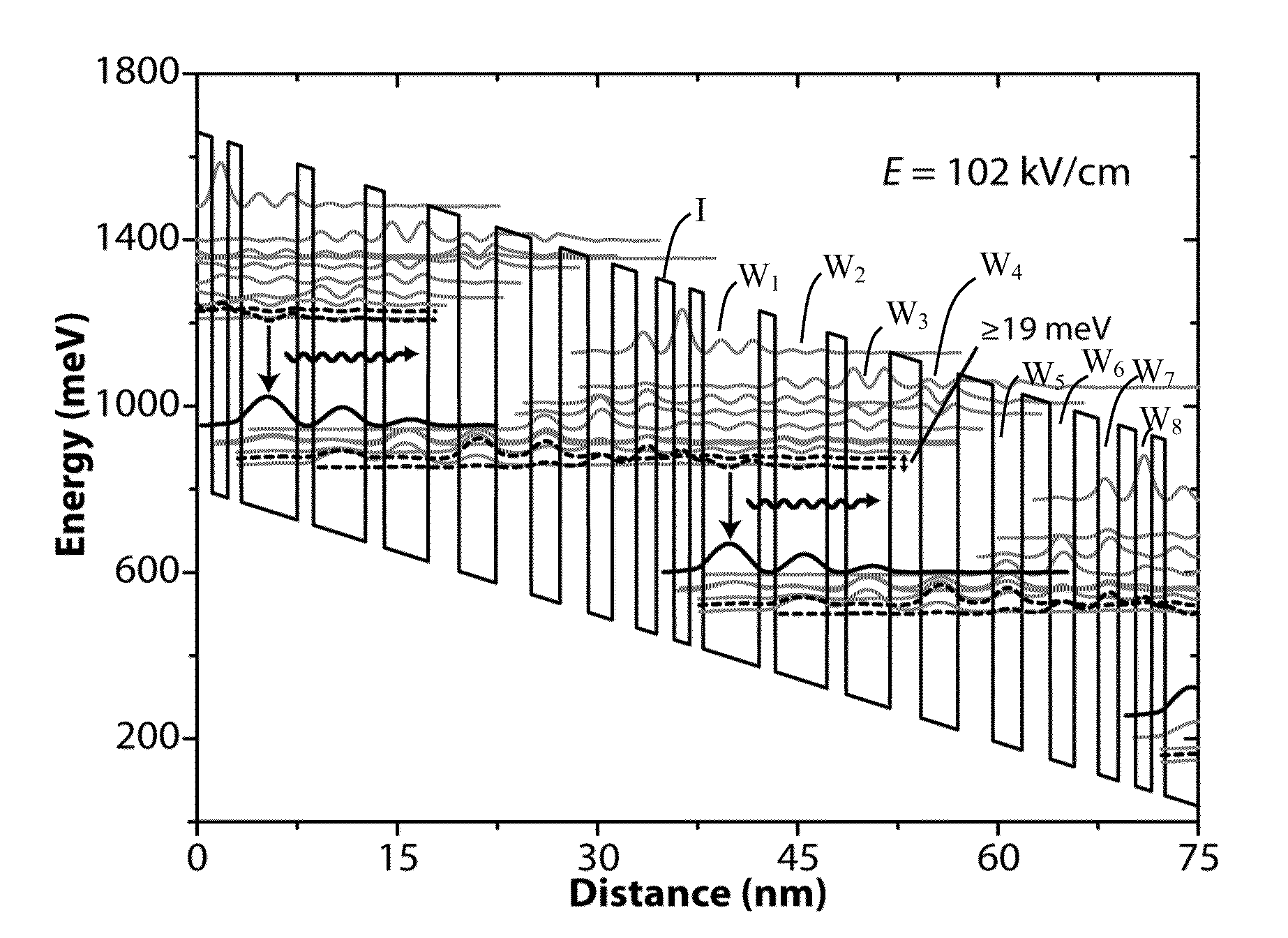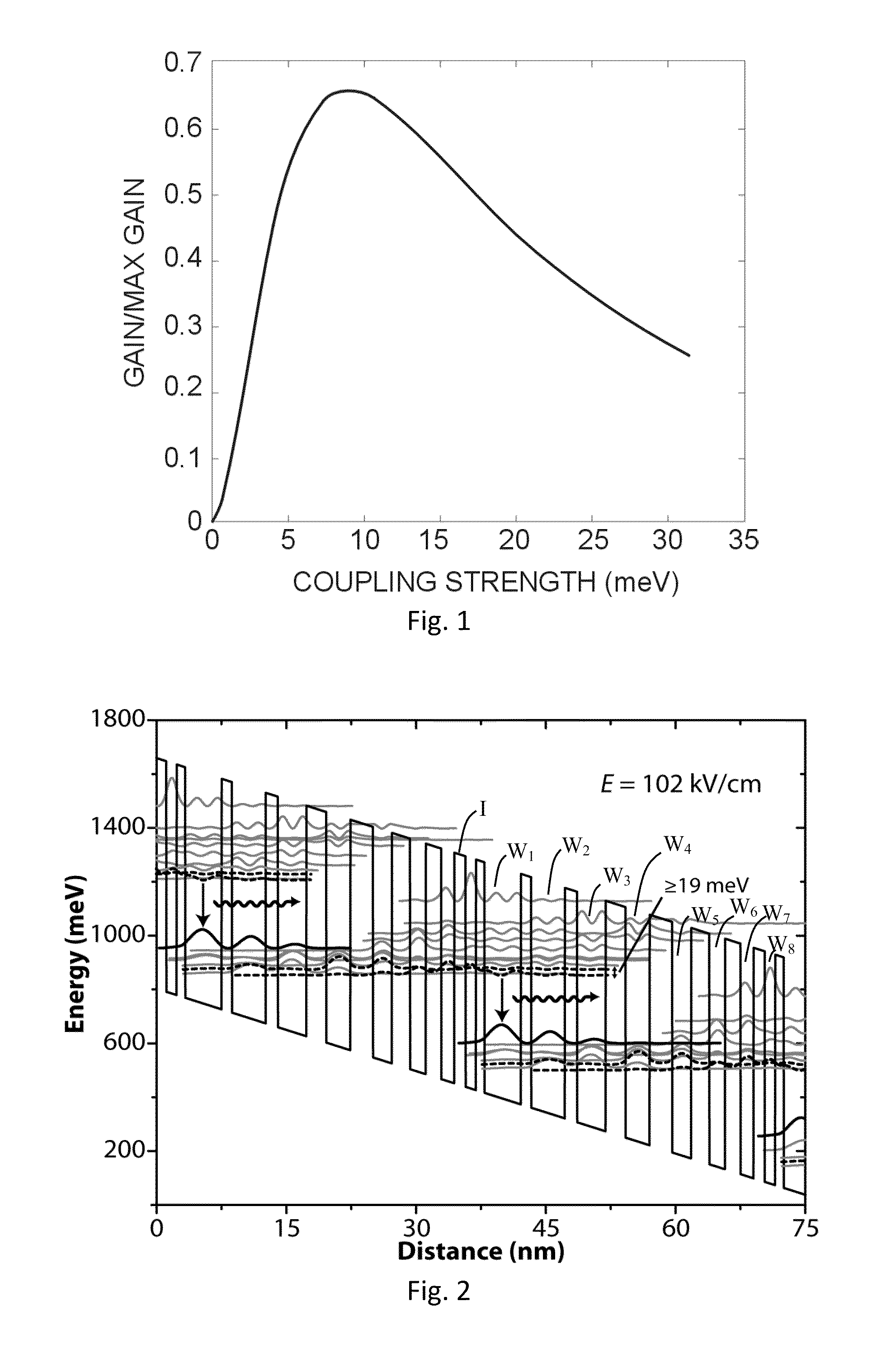Highly Power-efficient and Broadband Quantum Cascade Lasers
a quantum cascade laser, high-power-efficient technology, applied in lasers, lasers, semiconductor lasers, etc., can solve the problems of uneven interface between adjacent semiconductor layers, large increase in the number of quantum cascade lasers, and poor temperature performance, and achieve wide gain spectrum, good temperature performance, and large gain spectrum width
- Summary
- Abstract
- Description
- Claims
- Application Information
AI Technical Summary
Benefits of technology
Problems solved by technology
Method used
Image
Examples
example 1
[0042]Exemplary QC laser structures (and electroluminescent structures) according to the design of FIG. 2 were grown by metal organic chemical vapor deposition (MOCVD) on InP substrate using strain-balanced In0.660Ga0.340As / Al0.690In0.310As materials and consisted of a low-loss InP-based waveguide cladding on top of 43 repeats of the injector / active regions sequence. Each injector region had a sheet doping density of 1×1011 cm−2. Ridge-waveguide lasers were fabricated with ridge widths varying from 13.5-21.5 μm using conventional III-V semiconductor processing techniques. The ridges were wet-etched to ˜8 μm deep, a ˜0.3 μm SiOx insulation layer was deposited with PECVD, thin 30 / 300 nm Ti / Au top metal contacts were deposited through electron-beam evaporation, the substrate was then thinned down to ˜200 μm, and a 20 / 200 nm Ge / Au bottom metal contact was deposited. Exemplary devices with cavity lengths varying from 0.5-4.0 mm and as-cleaved facets were mounted epitaxial-side up to copp...
example 2
[0046]Exemplary QC laser structures according to the design of FIG. 7 were grown by metal organic chemical vapour deposition (MOCVD) on InP substrate using strain-balanced In0.652Ga0.348As / Al0.690In0.310As and consisted of a low-loss InP-based waveguide surrounding 41 repeats of the injector—active region sequence. The injector had a sheet doping density of 1×1011cm−2. Electroluminescence (EL) structures were fabricated as deep-etched, 200 μm diameter mesas with Ti / Au (250 / 2500 Å) top and Ge / Au (250 / 2500 Å) bottom contacts. The mesas were mounted to a copper heat sink. The lasers were fabricated as deep-etched ridge waveguide lasers with ridge width of around 10 μm and SiO2 (3300 Å) for side-wall electrical insulation. The devices were thinned to ˜200 μm and top Ti / Au (230 / 2500 Å) and bottom Ge / Au (230 / 2500 Å) contacts were deposited. The ridges were cleaved to various lengths and mounted epitaxial side up to copper heat sinks.
[0047]Electroluminescence spectra were collected for var...
examples
[0052]Exemplary prototype devices based on designs A and B (with the continuum-to-bound active regions) were grown by solid source molecular beam epitaxy (MBE) with InGaAs / InAlAs quantum wells lattice-matched to an InP low-doped substrate (doped n˜1−2×1017 cm−3). The active core included 40 periods of injector and active regions. A 0.6 μm InGaAs (doped n˜5×1016 cm−3) layer was grown below the active region for mode confinement; a 0.3 μm InGaAs (doped n˜5×1016 cm−3) top mode confinement layer and a 2.8 μm AlInAs (doped n˜1×1017 cm−3) top cladding layer were grown above the active core, followed by a 0.6 μm InGaAs plasmon layer (doped n˜1×1019 cm−3) and a final 300 Å thick layer of InGaAs (doped n˜2×1019 cm−3) as the contact layer. The wafer was processed into 200 μm diameter circular mesas as well as deep-etched ridge lasers with different ridge widths (from 11 to 20 μm).
[0053]Electroluminescence from a semi-circular cleaved mesa based on design A (˜23 meV splitting) was measured at ...
PUM
 Login to View More
Login to View More Abstract
Description
Claims
Application Information
 Login to View More
Login to View More - R&D
- Intellectual Property
- Life Sciences
- Materials
- Tech Scout
- Unparalleled Data Quality
- Higher Quality Content
- 60% Fewer Hallucinations
Browse by: Latest US Patents, China's latest patents, Technical Efficacy Thesaurus, Application Domain, Technology Topic, Popular Technical Reports.
© 2025 PatSnap. All rights reserved.Legal|Privacy policy|Modern Slavery Act Transparency Statement|Sitemap|About US| Contact US: help@patsnap.com



